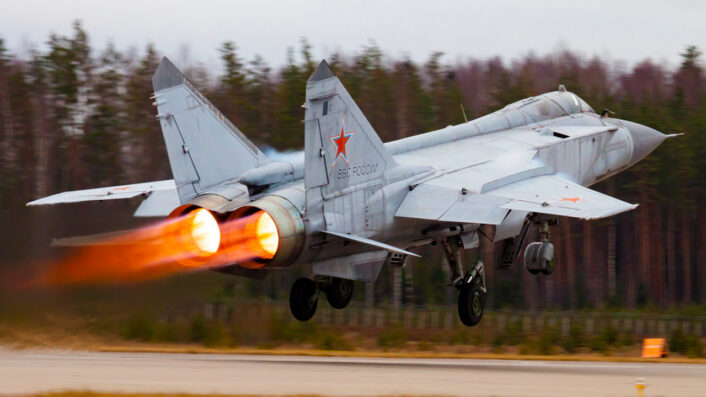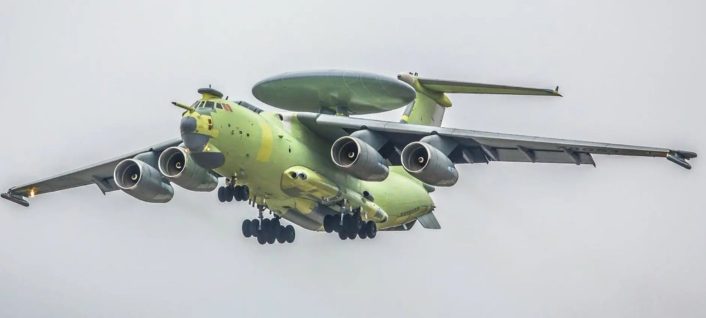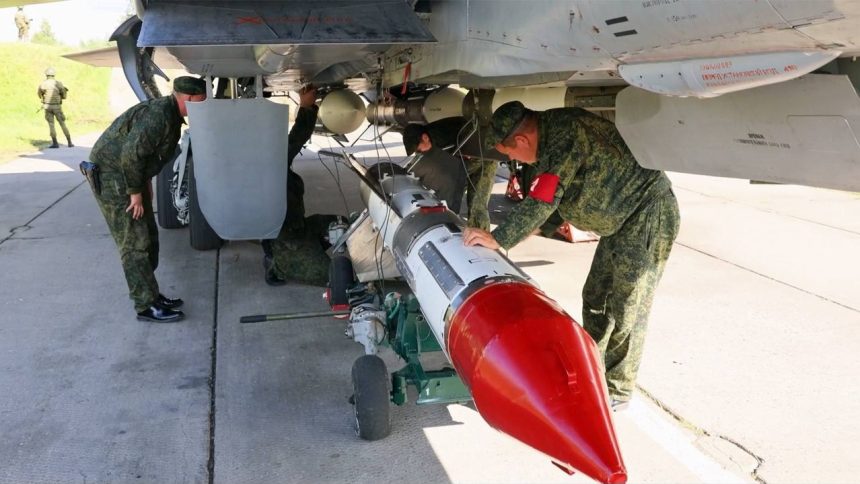The Cold War-era nuclear-capable R-33 long-range air-to-air missile was designed to destroy large strategic bombers and supersonic targets, such as the B-52 Stratofortress, the SR-71 Blackbird and the canceled XB-70 Valkyrie.
A video from the RuMoD (Russian Ministry of Defense) showing the ongoing “non-strategic nuclear readiness exercise” featured an R-33 AAM (Air-to-Air Missile) being loaded on a MiG-31 (NATO reporting name: “Foxhound”) fighter jet. The missile has been said to be capable of carrying a nuclear warhead, marking an unusual capability for an anti-air munition that, while not unprecedented (the US once had the AIM-26 Falcon), has no parallel in other air forces.
Although not explicitly stated, given the context of the exercises, the security measures and the formal classification of the drills as part of a “non-strategic nuclear forces” exercise, might imply that the R-33 is indeed nuclear capable. Should this be correct, the question remains whether the missiles were the conventional warhead variant or the nuclear warhead variant.
The video released by the RuMoD on Aug. 1, 2024, shows the Iskander/Iskander-M nuclear-capable tactical ballistic missile being loaded onto a TEL (Transporter-Erector Launcher) truck. The next segment shows ground crews carting an R-33 on a trolley and loading it on the underbelly hardpoint of the MiG-31. There are already three other such missiles on the ventral pylons, with this being the fourth one.
As part of the same third stage exercises the #Russian air force practised mounting a R-33 missile with a #nuclear warhead to a MIG-31. https://t.co/iC6rpCM3JG pic.twitter.com/xFiDTk8scR
— Ninjamonkey 🇮🇳 (@Aryan_warlord) August 2, 2024
The accompanying RuMoD statement said: “As part of the third stage of the non-strategic nuclear forces exercise, the personnel of the missile formations of the Southern and Central Military Districts and the involved aviation units of the Aerospace Forces worked out issues of receiving special training ammunition, reaching designated areas and began equipping launch vehicles and aircraft weapons.”
Under what circumstances will it be employed and whether Russia would proceed with using such an unusual, yet escalatory, weapon will be examined subsequently.
The R-33 missile
The R-33 (NATO reporting name: AA-9 Amos) is a long range AAM introduced by the Soviet Union in 1981, to be used by high-altitude and fast-flying interceptors like the MiG-31 in combination with the powerful Zaslon PESA (Passive Electronically Scanned Array) radar.
The original R-33 is claimed to have a range of 120 km, while the improved R-33S variant introduced in 1990 can reach distances up to 160 km. With a maximum speed of nearly Mach 4.5, the missile was designed to destroy not only large strategic bombers like the B-52 Stratofortress, but also high-speed targets such as the SR-71 Blackbird and the canceled XB-70 Valkyrie Mach 3 bomber.
The R-33 has also been designed for other two types of targets: cruise missiles, like the AGM-86 ALCM (Air Launched Cruise Missile), and high value assets such as the E-3 AWACS (Airborne Warning and Control System). The employment against highly subsonic low-flying cruise missiles is also possible thanks to the combination of the missiles SARH (Semi-Active Radar Homing) guidance which receives continuous updates from the Zaslon radar, which reportedly has a ‘look-down shoot-down’ capability.
In 2019, the RuAF also introduced the R-37M (NATO reporting name: AA-13 Axehead) in service, derived from the R-33. Its export variant is designated as the RVV-BD (literally Long Range Air-to-Air Missile from Russian). Assessments based on Russian reports put its range at 400 kilometers, more than double of the R-33’s.

The missile has been modified, compared to the R-33, so it can be employed by other aircraft. For an instance, the tail controls are now folding for carriage by aircraft smaller than the MiG-31 and the SARH guidance has been replaced by an ARH (Active Radar Homing) seeker for the terminal phase of the flight, allowing the use by aircraft not equipped with the Zaslon radar.
The War Zone reported in 2020 that the R-37 was introduced for the ‘BM’ variant of the MiG-31, the new standard to which the RuAF (Russian Aerospace Forces) is upgrading its aircraft. TWZ also added that “like the R-33 that preceded it, the R-37M is said to be capable of being armed with a nuclear warhead for destroying larger formations of aircraft or missiles.” The RuAF received in mid-July a new batch of modernized MiG-31BM fighters from the Sokol Aircraft Plant in Nizhny Novgorod.
The core upgrade of this variant is the Zaslon-AM radar, which has a range twice of the older radar, with claims stating it is able to spot a fighter-size target at 240 km (according to some sources even 320 km). The new MiG-31BM also replaced the older R-60 (NATO reporting name: AA-8 “Aphid”) IR-guided AAM with the newer R-73 (AA-11 “Archer”) and the obsolete R-40 (AA-6 “Acrid”) long-range AAM with the R-77 (AA-12 “Adder”).
#ColdWar interception load on MiG-31, 4 R-33 under fuselage are well known due to similarity with Phoenix on F-14. But R-40 is a Soviet marvel its the largest A2A missile ever developed (over 6m long). Iraqi MiG-25 claimed F-15 kill with R-40 in first Gulf War but US denied loss pic.twitter.com/bVZLvwG8W1
— ST (@aviation07101) February 13, 2021
Use of a nuclear-capable AAM
As discussed previously at The Aviationist, Russia generally lags behind the West in combat support platforms like AEW&C (Airborne Early Warning and Control) and aerial refueling tankers. For the AEW&C roles, the RuAF only has six A-50Us, after two were shot down by Ukraine, and is developing the newer A-100.
For ISR (Intelligence, Surveillance and Reconnaissance) and ELINT (Electronic Intelligence) roles, Russia has the Tupolev Tu-214R, which is also equipped with COMINT (Communications Intelligence) and SIGINT (Signals Intelligence) capabilities, along with a GPR (Ground Penetrating Radar) and a SAR (Synthetic Aperture Radar). However, it has only two of these aircraft, nowhere close to the numbers the US and European NATO nations can field the RC-135 Rivet Joint or the E-3 Sentry AWACS.
Russia therefore developed its concept of operations with the R-33 and R-37 missile to neutralize this overwhelming advantage in certain aspects of air superiority enjoyed by NATO. Similarly to the US-made Cold War era AIM-26 Falcon, the nuclear variant of the R-33 and R-37 could be used against large formations of aircraft, especially against high-altitude, high-speed targets which at long range would easily evade a conventional direct hit or proximity fuse warhead.

Bluff, warning or both?
The use of this weapon could be a highly escalatory measure taken in desperate situations when the military situation looks bleak for Russia. However, it would have a series of geopolitical implications far beyond Europe.
It must also be noted that the RuAF also primarily perceives the R-33 as a conventional AAM, seen in intercepts of the MiG-31 by NATO air forces over the last few years. One such intercept by Norwegian F-35As in Mar. 2020, saw a MiG-31 carrying the full load of four R-33s. Another intercept in Mar. 2023 saw the same loadout.
At 10:45 today, 2 Norwegian F-35s were scrambled for a #NATO Quick Reaction Alert mission from Evenes, #Norway. The F-35s identified 2 Russian military aircraft in int. airspace outside Norway: a SU-24 (“Fencer”) and a MIG-31 (“Foxhound”). Photo: MiG-31 and NOR F-35. #WeAreNATO pic.twitter.com/B6PFFboM9m
— Norwegian Armed Forces | Forsvaret (@Forsvaret_no) March 14, 2023
As discussed in previous reports about Russian and American nuclear controls and policies, the use of even a small tactical nuclear missile meant to explode mid-air will require the highest authorization from Russia’s 12th Main Directorate and the Kremlin. The decision would be taken with a careful strategic assessment of the geopolitical situation.
Likewise, featuring the missile in official material can also have a psychological effect, with strategic messaging goals directed at NATO. Probably, this is Moscow’s way to deter the West and Ukraine after the delivery of the F-16s to Ukraine. However, we must note the possibility of the missiles shown in the video being standard R-33 “masked” as nuclear-tipped, as happened in earlier exercise with Su-25 supposedly armed with nuclear bombs which in reality were standard bombs adapted to simulate the nuclear warhead.









